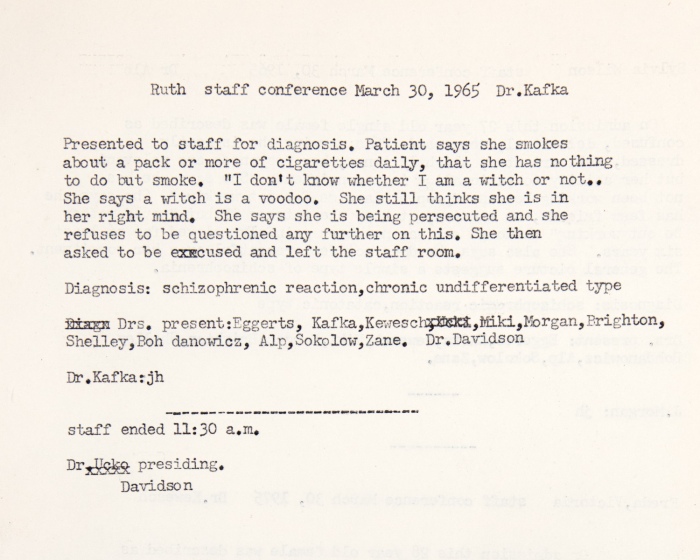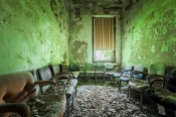AbandonedNYC
Essex County Hospital
Found in Essex County Hospital
I outlined New Jersey’s Essex County Hospital in a previous post, but a few months back I made it out a second time to explore a little further. I ended up in the tunnels underneath the wards, where I found a file room stuffed with material dating from the 1930s to the 1980s, near the last years of Essex County Hospital’s operation. The records are scattered in cardboard boxes with no apparent system of organization, many of them overtaken with mold and rot.
Much of what’s been left here is mundane, day-to-day operational notes on staff, time sheets, and maintenance, but some of it is rather enlightening. There are decades’ worth of doctor’s notes, admission records, and log books detailing the daily activities of individual residents, some describe a patient’s entire life story in a single paragraph. The scale of it is truly overwhelming when you start flipping through the files page by page.
As I’ve mentioned before, many of the patterns of neglect well-documented in the age of institutions have shifted to the criminal justice system today. In New York City, the mentally ill now account for 40% of the prison population. To make matters worse, an epidemic of violence against mentally ill inmates at Rikers Island came to light this summer, causing an uproar. Now, the de Blasio administration is pushing for a major $130 million initiative that strikes at the heart of the problem, aiming to keep repeat low-level offenders out of prison and get them into treatment programs. From the Times article: “The changes include tripling the size of both pretrial diversion programs and the amount of resources devoted to easing the transition from jail back into society. This would represent a significantly different approach to criminal justice in the city, experts said. But they cautioned that nothing of such scale had been tried by a municipality before, and that putting the plan into effect would be difficult.”
As we look forward, it’s worth taking a moment to look back. What follows is a tiny sampling of the massive amount of records, artifacts, and ephemera left behind in the wards of Essex County Hospital and that moldy file room in the basement. You can read for yourself, just click to enlarge.

Belongings left in a storage room (most likely meticulously arranged by a previous visitor to the abandoned building.)
Overbrook Asylum/Essex County Hospital

The chairs in this patient room were undoubtedly arranged by a previous visitor to the abandoned hospital.
It seems that everyone in Cedar Grove, New Jersey has a spooky story or two about the Overbrook Asylum. Though it only closed down officially in 2007, the complex has long been home to abandoned buildings, and local lore has been quick to populate them with unexplained voices, vengeful spirits, and mysterious presences. Situated among public parks and residential neighborhoods, the decaying asylum known by many as “the Bin” has become a well-known hangout for teenagers, ghost hunters, scrappers, and other curious parties, much to the consternation of local law enforcement. In 2008, the local sheriff amped up police presence on the property, leading to 34 arrests over the course of 3 days, though it was rented out as a location for the tacky Travel Channel series “Ghost Adventures” the same year. Rumors of 24/7 surveillance still serve to ward off would-be trespassers, but on the gloomy Sunday morning I set out to explore the aging asylum, not a soul, living or dead, patrolled the 100-acre grounds of the old Essex County Hospital.

A clock stopped in an employee kitchen.
I won’t rehash the history here that most every American asylum shares. (For a more detailed account, read up on psychiatric treatments at Kings Park Psychiatric Center and the “farm colony” design of Letchworth Village.) Suffice it to say that the good intentions Overbrook was founded on in 1896 couldn’t hold up to the harsh realities of overcrowding and underfunding that characterized mid-20th century institutions. This dark period of neglect ended, for the most part, with the development of new “wonder drugs” for the treatment of serious mental disorders, which led to the abrupt closure of asylums across the country.
Though there’s little to differentiate the history of Overbrook Asylum from the dozens of similar institutions across the northeast, one particularly notorious episode stands out. On Dec 1st, 1917, the hospital’s heating and lighting plant broke down, sending temperatures plummeting inside the dormitories. As a cold snap hit New Jersey in the following weeks, 24 patients died as a result of or in conjunction with exposure, along with 32 cases of frostbite. In an act of desperation, the medical superintendent sent out letters to patient’s families in the hope that many would come to retrieve their relatives, who he admitted were living in “far from comfortable” conditions.
Even in the best times, “comfortable” isn’t the first word that comes to mind when describing the way of life of the thousands of mentally ill patients who called Overbrook home. An impressive amount of artifacts remain throughout the maze of interconnected dormitories, offering a look into the individual lives that make up its collectively tragic history. At every turn, large-scale photo murals of nature scenes and wildlife adorn the beige and sea foam walls of the wards. Elsewhere, holiday decorations clutter the floor. Stockpiled in cabinets are jolly snowmen, grinning halloween skulls, festive scarecrows, and gleaming easter bunnies, anything to distract from the clinical gloom of the wards. Out of the clustered piles of clothing, medical supplies, and craft projects, the terse, impersonal lines of a handwritten card speak volumes on the isolation of the unfortunate men and women who spent their lives forgotten behind asylum walls: “Dear John, I hope you are well and happy. I’m feeling okay. Miss you. Love, Mom.”

One narrow cell was overtaken by moss and mold.
The decrepit hospital closed down in 2007 when a new state of the art facility opened up nearby, which still operates today. By that time much of the property had already been long abandoned, with a dwindling patient population due in large part to the effective treatments developed in the 60s and 70s, as well as the pressure to discharge anyone who wasn’t a threat to themselves or others, no matter how unprepared they were to get by on their own in the outside world. Contrary to a few adamant commenters in online forums, most of the Overbrook campus is still standing on the east side of Fairview Avenue. A development plan to demolish the complex soon after it closed in 2007 would have brought 78 luxury single family homes to the area, but it never panned out. Today, the property is county-owned. Though plans were put in place to convert the land to a public park in 2008, little progress has been made in that regard.
As Overbrook continues to crumble, the treatment of the mentally ill has been making headlines in recent months, and it’s troubling to see the same familiar patterns play out in an even more brutal setting—the prisons cells and solitary confinement units where many of today’s mentally ill end up. A recent article in the New York Times outlines a harrowing study of an epidemic of violence toward mentally ill inmates at Rikers Island which rivals the worst cases of abuse in the age of institutions. Earlier this week, a positive step was made on the West Coast, where the California Department of Corrections has introduced new standards for the treatment of the mentally ill living in the prison system. Here’s hoping this results in legitimate changes that can be instituted across the country.































